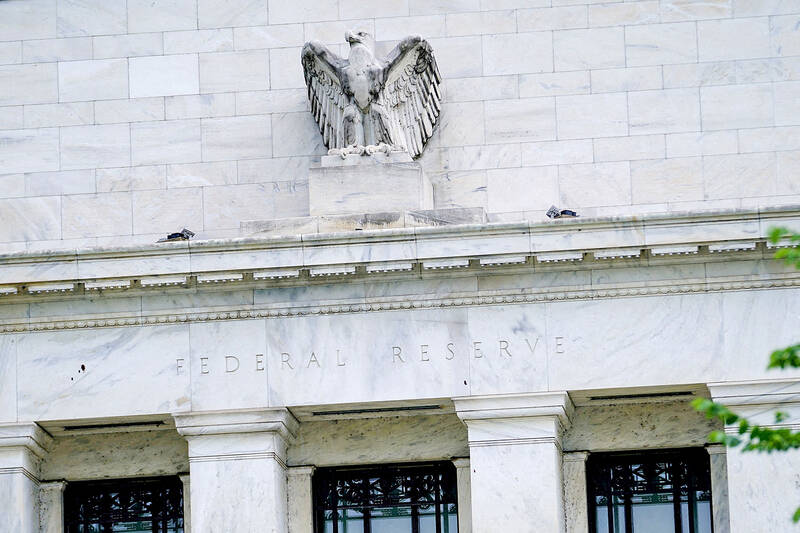The US Federal Reserve is likely to make one or two more rate cuts this year as it recalibrates policy to focus on the labor market, a senior bank official said on Wednesday.
Fed policymakers voted 11-to-1 in favor of cutting the bank’s key lending rate by half a percentage point last month, bringing the bank’s key lending rate down from a 23-year high, with Fed Governor Michelle Bowman the only voting member of the committee to publicly back a smaller cut.
Speaking in the US state of Idaho on Wednesday, San Francisco Fed President Mary Daly said she had backed a larger cut last month to “recalibrate” monetary policy.

Photo:Reuters
Daly was among the vast majority of members on the Fed’s rate-setting committee to vote for the bigger rate cut, which lowered the US central bank’s key lending rate to between 4.75 and 5 percent.
“We were patient. We saw that the things we were marching towards have started to evolve,” she said, adding “we adjust 50 basis points to get policy right-sized for the economy we have, and the one we expect to evolve going forward.”
Alongside the large cut, policymakers published updated economic forecasts in which they penciled in an additional 50 basis points of cuts over the two remaining meetings this year.
“I think that two more cuts this year, or one more cut this year, really spans the range of what is likely in my mind, given my projection for the economy,” Daly said.
However, she cautioned that the Fed was “data-dependent,” and policy would continue to be guided by the incoming data on inflation and the health of the labor market.
Futures traders see a roughly 80 percent chance that the Fed would move ahead with a 25 basis point cut at its next meeting early next month, according to CME Group data.
Separately, US consumer inflation cooled last month — though slightly less than expected — according to government data published yesterday, providing further evidence that price pressures are easing ahead of next month's US presidential election.
The consumer price index (CPI) slowed to 2.4 percent last month from a year ago, down from 2.5 percent in August, the US Department of Labor said in a statement.
This was slightly above the median forecast of economists surveyed by Dow Jones Newswires and The Wall Street Journal.
There was also some cause for concern for the Fed as it looks to cut interest rates: a measure of inflation that strips out volatile food and energy costs rose slightly to 3.3 percent, up from 3.2 percent in August, buoyed by a jump in the transportation services index last month.
Monthly headline inflation rose by 0.2 percent, while core inflation also exceeded forecasts to increase by 0.3 percent.
Despite the "slight upward surprise relative to what we're expecting," the inflation picture isn't all bad, Oxford Economics' deputy chief US economist Michael Pearce told AFP.
Given "the broader trend in services inflation, I think I'm still confident in the view that that's going to continue to trend lower over the next 12 months," he said.

The US dollar was trading at NT$29.7 at 10am today on the Taipei Foreign Exchange, as the New Taiwan dollar gained NT$1.364 from the previous close last week. The NT dollar continued to rise today, after surging 3.07 percent on Friday. After opening at NT$30.91, the NT dollar gained more than NT$1 in just 15 minutes, briefly passing the NT$30 mark. Before the US Department of the Treasury's semi-annual currency report came out, expectations that the NT dollar would keep rising were already building. The NT dollar on Friday closed at NT$31.064, up by NT$0.953 — a 3.07 percent single-day gain. Today,

‘SHORT TERM’: The local currency would likely remain strong in the near term, driven by anticipated US trade pressure, capital inflows and expectations of a US Fed rate cut The US dollar is expected to fall below NT$30 in the near term, as traders anticipate increased pressure from Washington for Taiwan to allow the New Taiwan dollar to appreciate, Cathay United Bank (國泰世華銀行) chief economist Lin Chi-chao (林啟超) said. Following a sharp drop in the greenback against the NT dollar on Friday, Lin told the Central News Agency that the local currency is likely to remain strong in the short term, driven in part by market psychology surrounding anticipated US policy pressure. On Friday, the US dollar fell NT$0.953, or 3.07 percent, closing at NT$31.064 — its lowest level since Jan.

The New Taiwan dollar and Taiwanese stocks surged on signs that trade tensions between the world’s top two economies might start easing and as US tech earnings boosted the outlook of the nation’s semiconductor exports. The NT dollar strengthened as much as 3.8 percent versus the US dollar to 30.815, the biggest intraday gain since January 2011, closing at NT$31.064. The benchmark TAIEX jumped 2.73 percent to outperform the region’s equity gauges. Outlook for global trade improved after China said it is assessing possible trade talks with the US, providing a boost for the nation’s currency and shares. As the NT dollar

The Financial Supervisory Commission (FSC) yesterday met with some of the nation’s largest insurance companies as a skyrocketing New Taiwan dollar piles pressure on their hundreds of billions of dollars in US bond investments. The commission has asked some life insurance firms, among the biggest Asian holders of US debt, to discuss how the rapidly strengthening NT dollar has impacted their operations, people familiar with the matter said. The meeting took place as the NT dollar jumped as much as 5 percent yesterday, its biggest intraday gain in more than three decades. The local currency surged as exporters rushed to